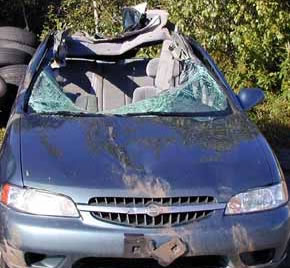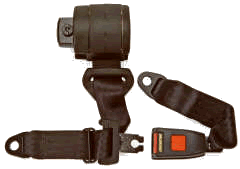Seat belts are life savers!
If you are not secured in the car you will continue to travel forward with that momentum until you hit something that can change that momentum to zero and bring you to a halt. If that happens in a short space of time - rapid change in momentum - you will experience a very large force on your body and internal organs. That may well kill you! Changing an object's momentum requires a force acting over a period of time.
impulse = change in momentum If momentum changes in a very small time period, such as in a car crash, then the force is very great. If the momentum can be changed over a longer period of time, even a fraction of a second more, much less force needs to be applied and this results in less damage to the car or injury to the occupants. In a head-on collision, if a passenger flies into the dashboard of a car, his/her momentum is instantly changed to zero, and serious injury is often the result. Seatbelts are made to stretch a bit if they experience a large force. Therefore when a sealtbelted passenger is restrained in a crash the belt stretches. This makes the passenger come to a halt over a short distance and his/her momentum is reduced gradually. This means that the seatbelt exerts a smaller force on the passenger than the dashbooard would do, if the unrestrained passenger was flung into it in a crash situation. The restraining force acting over a longer period of time reduces the force needed to change the momentum of the passenger. So, seatbelts can reduce the impact force acting on a passenger to one-fifth of the impact that would be suffered if the person hit the body of the car (for example the dashboard) by increasing the time of 'momentum change' by roughly five times. You may survive a crash if not 'buckled up' but when that happens you usually increase the time and reduce the impact force by rocketing forward through the windscreen (ouch!) or ploughing into the back of the neck of a passenger in front - perhaps not killing you (as the other person 'breaks your fall forward' by increasing your stopping time as you break their neck!) but killing them!
A seatbelt is designed to stretch a bit when the car decelerates rapidly. You travel forward a little while being stopped - you do not stop sharply as you would if you hit the dashboard. The seatbelt stretching increases the time over which your momentum is changed, thereby decreasing the force experienced by your body. Remember: change in momentum = time x force - if you increase the time factor the force factor will decrease. Limiting injury caused by the belt itself The force you experience on coming to a standstill when stopped by a seatbelt can stillcause significant damage to your chest and this needs to be made as small as possible. Your seatbelt provides the force to stop you - so you also have to think about pressure experienced too (width of the belt and the positioning of it are important if it is to save you without cutting into you). The belt should be wide and fit your body comfortably. It should not be twisted or have buckles or fitments that would cut into you.
See Air Bags and Crumple Zones they work on the same principle.
|
Follow me...
|


 If you have an accident in a car the car comes to an abrupt halt when you hit another car or wall, you will be travelling at the speed of the car when you have to come to an abrupt stop. If you are travelling at about 45 mph (that is about 20 m/s) you have considerable
If you have an accident in a car the car comes to an abrupt halt when you hit another car or wall, you will be travelling at the speed of the car when you have to come to an abrupt stop. If you are travelling at about 45 mph (that is about 20 m/s) you have considerable  SUMMARY
SUMMARY



